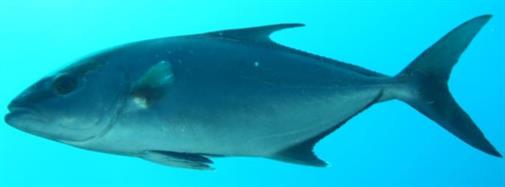



Seriola rivoliana
| Ecological Descriptors |
||||
| Habitat | Size (cm) | Diet | Behaviour | Sex |
| Dem, Pel | 90 | Pisc (Cru, Wor) | Sh, I | F |
Description:
Adults: Bluish to greenish on upper back, silvery below. Distinctive oblique dark band from snout, through the eye to front of dorsal fin. No scutes.Front dorsal fin long.
Juveniles (up to 20 cm) with oblique dark bar on head and 7 dark bars (each with a narrow, irregular pale vertical centerline) on side and tail base that do not extend onto dorsal and anal fin bases.
Ecology
Adults pelagic and demersal, at depths of 3 to 250m (10-800ft), but rarely found in inshore waters. Juveniles pelagic and occurring offshore, under floating plants and debris when small. Diet is primarily fishes, also invertebrates.
They can also be epibenthic, i.e. living near the bottom of the water. Younger ones live in algae beds, for example Sargassum. They feed mostly on other fish, and also other sea creatures including shrimps, crabs, octopus and squid. Almaco jacks are fast swimming and search for food both day and night, and are mainly found in small groups.
Life Cycle
Almaco jacks are known to form spawning groups. Spawning occurs throughout spring, summer and fall, depending on water temperature. Eggs are pelagic as well as larvae.
Adults: Bluish to greenish on upper back, silvery below. Distinctive oblique dark band from snout, through the eye to front of dorsal fin. No scutes.Front dorsal fin long.
Juveniles (up to 20 cm) with oblique dark bar on head and 7 dark bars (each with a narrow, irregular pale vertical centerline) on side and tail base that do not extend onto dorsal and anal fin bases.
Ecology
Adults pelagic and demersal, at depths of 3 to 250m (10-800ft), but rarely found in inshore waters. Juveniles pelagic and occurring offshore, under floating plants and debris when small. Diet is primarily fishes, also invertebrates.
They can also be epibenthic, i.e. living near the bottom of the water. Younger ones live in algae beds, for example Sargassum. They feed mostly on other fish, and also other sea creatures including shrimps, crabs, octopus and squid. Almaco jacks are fast swimming and search for food both day and night, and are mainly found in small groups.
Life Cycle
Almaco jacks are known to form spawning groups. Spawning occurs throughout spring, summer and fall, depending on water temperature. Eggs are pelagic as well as larvae.
Almaco Jack
Almaco Jack
Almaco Jack Juvenile
Synonyms:
Amberjack
Amberjack

(C) Ross Robertson




582

546




